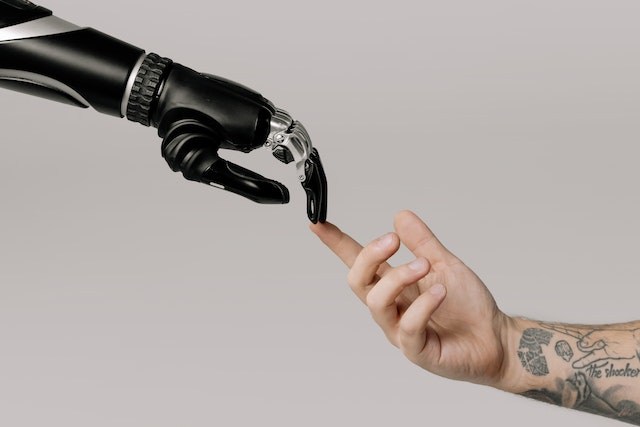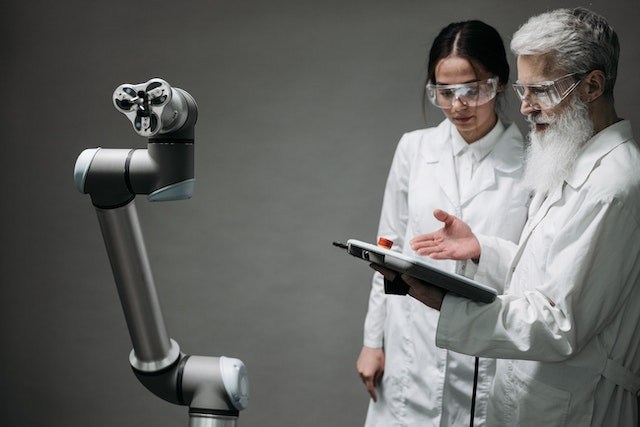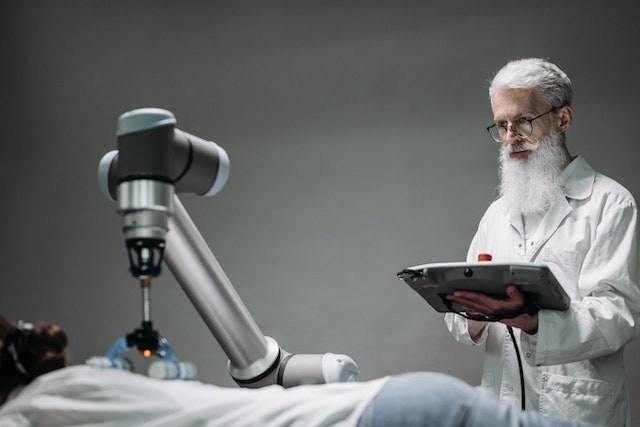AI-enabled surgical robots have revolutionized the field of minimally invasive surgery. These cutting-edge robots combine the precision of artificial intelligence with the dexterity of robotic arms, enabling surgeons to perform complex procedures with greater accuracy and control. By using advanced sensors and imaging technologies, these robots can navigate the human body with ease, minimizing the risk of complications and reducing recovery time for patients.
With the ability to access hard-to-reach areas and perform delicate tasks, AI-enabled surgical robots are transforming the way surgeries are conducted. They offer a new level of precision and efficiency that traditional surgical methods simply cannot match. As technology continues to advance, we can expect even more groundbreaking innovations in the field of surgical robotics, leading to improved patient outcomes and a brighter future for minimally invasive surgery.
The Rise of AI-Enabled Surgical Robots
Advancements in technology have paved the way for remarkable innovations in the field of surgery. One such breakthrough is the rise of AI-enabled surgical robots, which are revolutionizing minimally invasive surgery. These robots combine the precision and accuracy of artificial intelligence with the dexterity and skill of human surgeons, resulting in improved outcomes and enhanced patient care.
AI-enabled surgical robots offer numerous advantages over traditional surgical techniques. They can perform complex procedures with greater precision, reducing the risk of human error. These robots are also capable of working in tight spaces, allowing for smaller incisions and faster recovery times for patients. The use of AI in surgical robots enables real-time data analysis, providing surgeons with valuable insights and enhancing decision-making during operations.

One notable example of an AI-enabled surgical robot is the da Vinci Surgical System. This robotic platform has been widely adopted in various surgical specialties, including urology, gynecology, and general surgery. The da Vinci system consists of robotic arms controlled by a surgeon, who operates from a console equipped with a high-definition 3D camera and specialized instruments.
This setup allows for precise movements and unparalleled visualization, making it an invaluable tool in the operating room.
The rise of AI-enabled surgical robots is transforming the field of surgery, with the potential to revolutionize patient care. These robots are not meant to replace human surgeons, but rather to complement their skills and enhance their capabilities. By harnessing the power of AI, surgical robots are pushing the boundaries of what is possible in minimally invasive surgery, leading to better outcomes and improved quality of life for patients.
The rise of AI-enabled surgical robots is reshaping the landscape of minimally invasive surgery. With their precision, dexterity, and real-time data analysis capabilities, these robots are revolutionizing patient care and empowering surgeons to deliver the best possible outcomes. As technology continues to advance, we can expect further advancements in AI-enabled surgical robots, ultimately leading to a new era of surgical innovation.
→ Transforming the Future of Surgery: How Robotics and AI are Shaping Surgical Techniques
Advantages of Minimally Invasive Surgery with AI
In recent years, AI-enabled surgical robots have revolutionized the field of minimally invasive surgery, offering a range of advantages and advancements. These cutting-edge technologies are changing the way surgeries are performed, providing numerous benefits for both patients and surgeons alike.
One of the key advantages of AI in minimally invasive surgery is the improved precision and accuracy it offers. AI-enabled surgical robots can perform complex procedures with greater precision than human hands alone, reducing the risk of human error. This enhanced precision allows for more targeted and effective treatment, resulting in better outcomes for patients.

Another advantage of AI in minimally invasive surgery is the ability to access hard-to-reach areas of the body. Surgical robots equipped with AI technology can navigate through tight spaces and perform delicate procedures with ease. This allows surgeons to reach areas that would otherwise be difficult, if not impossible, to access using traditional surgical methods.
AI-enabled surgical robots can enhance the visualization of surgical procedures. By integrating advanced imaging technologies, these robots provide surgeons with a clear and detailed view of the surgical site. This improved visualization allows for better decision-making during surgery and helps surgeons identify potential complications or abnormalities.
Furthermore, AI in minimally invasive surgery can contribute to shorter recovery times for patients. The minimally invasive nature of these procedures, coupled with the precision and accuracy of AI-enabled robots, can result in reduced trauma to the body and faster healing. This means that patients can experience less pain, reduced scarring, and a quicker return to their daily activities.
The advantages of minimally invasive surgery with AI are numerous. From improved precision and access to enhanced visualization and faster recovery times, AI-enabled surgical robots are revolutionizing the field of surgery. These advancements not only benefit patients by improving outcomes but also provide surgeons with powerful tools to deliver the best possible care.
How AI-Enabled Surgical Robots Work
AI-enabled surgical robots are revolutionizing minimally invasive surgery by combining the precision of robotic technology with the intelligence of artificial intelligence. These advanced robots are designed to assist surgeons in performing complex procedures with greater accuracy and efficiency.
One key component of AI-enabled surgical robots is their ability to analyze and interpret medical imaging data in real-time. Using sophisticated algorithms, these robots can quickly identify and highlight areas of concern, providing surgeons with valuable insights during the procedure.

In addition to their imaging capabilities, AI-enabled surgical robots are also equipped with advanced sensors and instruments. These robots can sense and respond to changes in the surgical environment, making adjustments as needed to ensure optimal outcomes. This level of adaptability allows surgeons to perform intricate procedures with increased precision and safety.
"AI-enabled surgical robots have the potential to revolutionize the field of surgery by improving patient outcomes and reducing surgical complications."
Moreover, AI-enabled surgical robots are designed to work collaboratively with surgeons. Rather than replacing human surgeons, these robots act as trusted assistants, providing additional support and enhancing the overall surgical experience. Surgeons can control and manipulate the robot's movements, while benefiting from the robot's enhanced capabilities and real-time feedback.
AI-enabled surgical robots are transforming the landscape of minimally invasive surgery. By harnessing the power of artificial intelligence, these robots are able to analyze, adapt, and collaborate with surgeons, ultimately improving patient outcomes and revolutionizing the way surgeries are performed.
💡 Tip: Just like a skilled surgeon, AI-enabled surgical robots use advanced algorithms and sensors to perform precise and minimally invasive procedures. These high-tech assistants are revolutionizing the field of surgery by enhancing surgical capabilities and improving patient outcomes. So, when it comes to the future of surgery, it's clear that AI-enabled surgical robots are leading the way!
→ Revolutionizing Precision and Efficiency in Orthopedic Surgery Planning with AI
Benefits of AI-Enabled Surgical Robots
AI-enabled surgical robots are revolutionizing minimally invasive surgery, offering numerous benefits that significantly improve patient outcomes. These robots are equipped with advanced technology and artificial intelligence algorithms, allowing surgeons to perform complex procedures with precision and efficiency.
One of the key benefits of AI-enabled surgical robots is enhanced surgical precision. These robots can perform delicate movements and maneuvers with a level of accuracy that surpasses human capabilities. This precision minimizes the risk of human error and reduces the likelihood of complications during surgery. With AI algorithms constantly analyzing data and providing real-time feedback, surgeons can make more informed decisions and adjust their approach accordingly.
Another advantage of AI-enabled surgical robots is their ability to perform minimally invasive procedures. This means smaller incisions, reduced trauma to surrounding tissues, and faster recovery times for patients. By utilizing robotic assistance, surgeons can access hard-to-reach areas of the body with greater ease and precision, leading to better surgical outcomes and improved patient satisfaction.
AI-enabled surgical robots offer the potential for remote surgery. Surgeons can operate these robots from a different location, allowing them to provide expert care to patients in remote areas or during emergencies. This capability expands access to specialized surgical expertise and reduces the need for patients to travel long distances for treatment.
AI-enabled surgical robots have the potential to revolutionize minimally invasive surgery. By providing enhanced precision, enabling minimally invasive procedures, and offering the potential for remote surgery, these robots are improving patient outcomes and expanding access to high-quality surgical care. As technology continues to advance, the role of AI in surgery will undoubtedly become even more significant, further revolutionizing the field of medicine.
Challenges and Limitations of AI-Enabled Surgical Robots
Challenges and Limitations of AI-Enabled Surgical Robots:
In the field of surgery, AI-enabled robots have emerged as a revolutionary tool for performing minimally invasive procedures. These robots are equipped with advanced technologies that enable them to assist surgeons in complex surgical tasks, such as precise incisions and sutures. While they offer great promise, there are several challenges and limitations that need to be addressed.
One of the main challenges is the lack of haptic feedback. Unlike human surgeons, AI-enabled robots do not have the sense of touch, which can make it difficult for them to accurately understand the pressure and resistance of tissues. This limitation can affect the robot's ability to perform delicate tasks and may require additional supervision from human surgeons.
Another challenge is the high cost of implementing AI-enabled surgical robots. The advanced technology and equipment required for these robots can be expensive, making it difficult for smaller healthcare institutions to adopt them. This limitation restricts access to this technology and limits its potential benefits to a wider population.
AI-enabled surgical robots still require human intervention and supervision. While they can perform certain tasks autonomously, they are not yet capable of making complex decisions independently. The presence of a human surgeon is essential to ensure patient safety and to make critical decisions during the surgical procedure.
Furthermore, there are limitations in the training and education of surgeons to effectively utilize AI-enabled surgical robots. Surgeons need to undergo specialized training to operate these robots and understand their capabilities and limitations. This can pose a challenge in terms of time and resources required for training.
While AI-enabled surgical robots have the potential to revolutionize minimally invasive surgery, there are challenges and limitations that need to be addressed. The lack of haptic feedback, high implementation costs, the need for human intervention, and specialized surgeon training are some of the key areas that require further development.
Overcoming these challenges will be crucial in harnessing the full potential of AI-enabled surgical robots and ensuring their safe and effective use in surgical procedures.
The Future of Minimally Invasive Surgery with AI
Advancements in technology continue to shape the landscape of modern medicine, and one area that is experiencing significant transformation is minimally invasive surgery. With the integration of artificial intelligence (AI), surgical robots are revolutionizing the field, offering new possibilities and improved patient outcomes.
AI-enabled surgical robots are designed to assist surgeons in performing complex procedures with greater accuracy and precision. These robots are equipped with advanced imaging systems and machine learning algorithms that can analyze vast amounts of data in real-time. By providing surgeons with enhanced visualization and decision-making support, AI-enabled surgical robots are changing the way surgeries are conducted.
One of the key benefits of AI in minimally invasive surgery is its ability to improve patient safety. With the assistance of AI, surgeons can navigate through the body with greater ease and accuracy, minimizing the risk of complications and reducing the need for open surgeries. AI-enabled robots can adapt to the unique anatomy of each patient, allowing for personalized and customized procedures.
Furthermore, AI can help optimize surgical workflows by streamlining surgical planning and improving surgical precision. By analyzing preoperative data, AI algorithms can assist surgeons in identifying the most effective surgical approach, reducing operating time and improving patient outcomes. Moreover, AI-enabled robots can perform repetitive tasks with precision, freeing up surgeons to focus on more complex aspects of the procedure.
The future of minimally invasive surgery with AI looks promising. AI-enabled surgical robots have the potential to revolutionize the field, offering improved patient safety, enhanced surgical precision, and optimized surgical workflows. As technology continues to advance, the integration of AI in surgery will likely become more commonplace, leading to further advancements and better patient care.
Recommendations for Implementing AI-Enabled Surgical Robots
Enhancing Precision and Efficiency in Minimally Invasive Surgery
Advances in AI technology have paved the way for the development and implementation of AI-enabled surgical robots, revolutionizing minimally invasive surgery. These robotic systems offer improved precision, enhanced visualization, and increased efficiency in surgical procedures. To ensure the successful integration of AI-enabled surgical robots in healthcare settings, several recommendations can be considered.
Comprehensive Training and Education
Healthcare professionals must receive thorough training and education on operating AI-enabled surgical robots. This includes understanding the system's functionalities, troubleshooting potential issues, and interpreting the data provided by the AI algorithms. By equipping surgeons and operating room staff with the necessary skills, the potential of AI-enabled surgical robots can be fully harnessed.
Collaboration between Surgeons and AI Algorithms
AI-enabled surgical robots should be designed to work collaboratively with human surgeons. This involves developing intuitive interfaces and control systems that allow surgeons to easily interact with the robotic system. AI algorithms should be tailored to enhance surgeons' decision-making, providing real-time guidance and analysis during surgical procedures.
Ethical Considerations and Patient Safety
The integration of AI-enabled surgical robots should prioritize patient safety and ethical considerations. Clear guidelines and protocols must be established to ensure the responsible and ethical use of AI in surgery. Robust cybersecurity measures should be implemented to protect patient data and prevent unauthorized access to the robotic systems.
Continuous Research and Development
To stay at the forefront of AI-enabled surgical robotics, continuous research and development efforts are crucial. Collaboration between academia, industry, and healthcare providers can drive innovation in this field. This includes exploring new AI algorithms, improving surgical robot designs, and evaluating the long-term outcomes and benefits of AI-enabled surgeries.
Implementing AI-enabled surgical robots in minimally invasive surgery holds immense potential. By following these recommendations, healthcare institutions can successfully integrate this technology, leading to improved patient outcomes, enhanced surgical precision, and increased efficiency in surgical procedures.
With all this in mind
In conclusion, AI-Enabled Surgical Robots have revolutionized minimally invasive surgery, offering unprecedented precision and improved patient outcomes. With their ability to enhance surgical procedures and assist surgeons in complex tasks, these robots have opened up new possibilities in the field of surgery. While there are challenges and limitations to overcome, the future of surgery with AI looks promising.
As technology continues to advance, we can expect further advancements in AI-Enabled Surgical Robots, ultimately benefiting both surgeons and patients alike.
Key Takeaways
- AI-Enabled Surgical Robots are transforming the field of surgery by offering increased precision and improved patient outcomes.
- Minimally Invasive Surgery with AI provides numerous advantages, including reduced scarring, shorter recovery times, and less postoperative pain.
- The working principles of AI-Enabled Surgical Robots involve combining AI algorithms and robotic systems to assist surgeons during procedures.
Frequently Asked Questions
What are the advantages of using AI-Enabled Surgical Robots in minimally invasive procedures?
AI-Enabled Surgical Robots offer advantages such as increased precision, reduced scarring, shorter recovery times, and improved patient outcomes.
How do AI-Enabled Surgical Robots work?
AI-Enabled Surgical Robots combine artificial intelligence algorithms with robotic systems to assist surgeons during procedures. These robots can analyze real-time data, provide surgical guidance, and perform complex tasks with high precision.
What are the benefits of AI-Enabled Surgical Robots?
The benefits of AI-Enabled Surgical Robots include improved surgical outcomes, reduced risk of complications, enhanced surgical precision, shorter hospital stays, and faster recovery times for patients.
What are the challenges and limitations of AI-Enabled Surgical Robots?
Challenges and limitations of AI-Enabled Surgical Robots include high costs, limited accessibility, regulatory concerns, potential for technical errors, and the need for skilled surgeons to operate the robots effectively.
How can AI-Enabled Surgical Robots shape the future of minimally invasive surgery?
AI-Enabled Surgical Robots have the potential to shape the future of minimally invasive surgery by further improving surgical precision, expanding the range of procedures that can be performed, and enhancing patient outcomes through data-driven insights.
